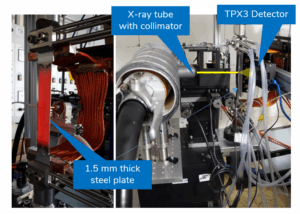

In April 2018, the AIDA-2020 project hosted its second Academia Meets Industry (AMI) Symposium in Bologna, Italy. This event aims to promote idea exchange between academic researchers and industry leaders with experience or interest in using detectors for non-destructive testing (NDT).
NDT is a minimally damaging technique that uses radiation sources and detectors for evaluating materials, components and systems to ensure all aspects of a system function correctly, reliably and cost-effectively.
Our sales manager, Tomas Hofbauer, was on location to share and discuss our radiation imaging detectors with the scientific and industrial figures. Hofbauer shares his thoughts about this event: “The next release of our product is in June and we wanted to get feedback from users at the AMI. Coming here allowed us to better understand the issues our industrial clients are facing and to see what our competitors are offering. In the end, we are not selling a detector but a solution that responds to our clients’ needs. The illustrative example of such an approach is the new robotic NDT system provided and exhibited at AMI by Radalytica s.r.o.”
In 2016, NDT was a market of 15 billion dollars with a forecasted compound annual growth rate (CAGR) of 8 to 10%. The X-ray detection technologies used in NDT are similar to the technologies used in high-energy physics, which was very apparent in the presentations by the 14 industry and four academia speakers. Besides the speeches, the 87 participants (31 from industry and 56 from academia coming in total from 18 countries) had the possibility to meet in business-to-business (B2B) meetings and gather at twelve company booths. The whole “business ecosystem” was present with representatives from the whole value chain: designers, producers, integrators and end users.
Advacam aims to reach all potential industrial figures and help them in their NDT needs. Our
2(1)X5 camera offers built-in Digital Time-Delayed-Integration (DTDI) for scanning in industrial applications. It is very advantageous for scanning large objects or for CT scanning, where some parts of rotating object can leave field of view.
2(1)X5 is available with Si and CdTe sensors for imaging of the soft and hard X-ray spectrums, respectively.



